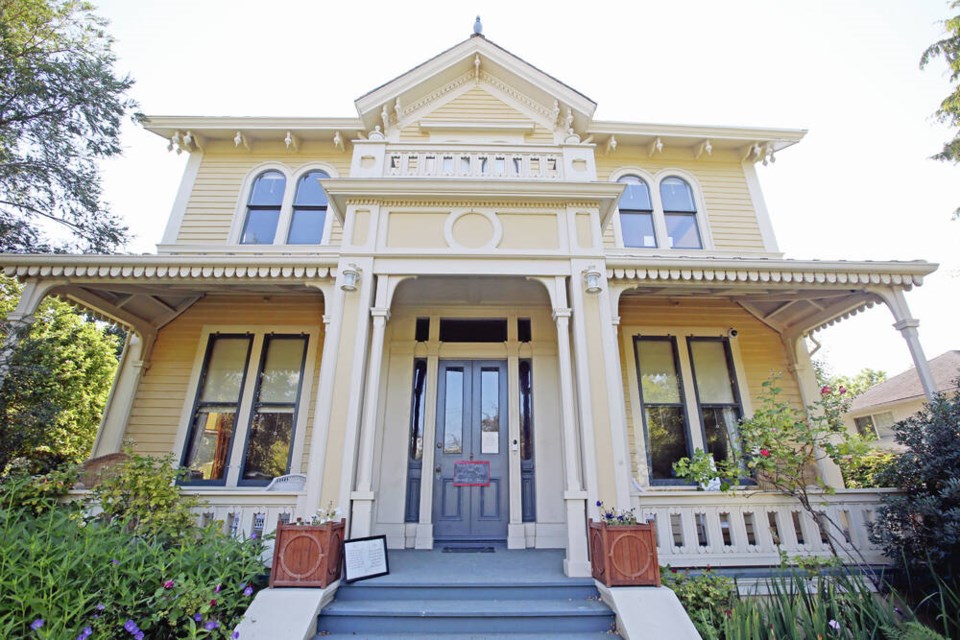Set back from the street in James Bay, the soft yellow house is like so many heritage houses in Victoria, except its former resident is what makes this two-storey, Picturesque-Italianate villa-style house worthy of national heritage status.
The charming house was the birthplace of one of Canada’s most famous painters, Emily Carr, who lived in the two-storey abode for the first 17 years of her life (from 1871 to 1888).
Emily Carr House, located at 207 Government St. near Beacon Hill Park, was built in 1863 for Carr’s father, Richard Carr, by prominent West Coast architect John Wright, and was in the Carr family for generations.
After being closed during the pandemic, Emily Carr House is once again open to the public, who can book guided tours Wednesday to Sunday or take a self-guided tour on Tuesdays. (Admission is by donation).
The upstairs, which used to house the family of a live-in site manager, is now unoccupied and forms part of the tour.
It was on a recent tour with guide Pascale Halliday that I learned more about the history of the house and the artist, who was not only a painter and author but was one of the first political cartoonists in Canada.
Emily was one of five sisters born to Richard and his wife Emily Saunders, who both came from England but met in San Francisco. When Elizabeth, the last of the sisters to live in the house, died in 1936, the two surviving sisters Emily and Alice sold the house to a private owner who turned it into a boarding house.
“They actually have Emily’s journals from this time and she writes about packing up her childhood home. She writes about it as a fine old lady of a house,” says Halliday.
Unfortunately, the house would not be properly maintained and a fire would eventually damage part of it.
There were plans to have the house torn down, but luckily it was saved from demolition by Victoria MP David Groos, who had the foresight to realize Emily Carr’s birthplace was a national treasure.
Groos took out a second mortgage on his own home to buy the property in 1964 and in 1967 The Emily Carr Foundation was formed to partner with the federal government to restore the house. Groos sold the house in 1970 and by 1976 it was declared a national heritage site.
Since reopening, about 50 to 60 people take the guided tours daily on weekends and about 25 on weekdays, says Halliday.
“A lot are locals who never visited the house before and who are interested in seeing the upstairs that was never open before,” she says
The upstairs bedroom where Emily was born can be seen much as it was when the artist was born.
Halliday points out the narrow closet in the room was considered a luxury at the time.
Another luxury item the family had is also evident upstairs — one of Victoria’s first indoor bathrooms. Emily’s father added indoor plumbing to the house in the 1880s. Although the bathroom has been modernized, the blue paint colour is original as are many of the windows in the room.
While most of the family’s belongings and furniture pieces are long gone, upstairs has a few of the original pieces.
The parent’s bedroom has one of the luggage trunks Emily and her sister Alice used when they travelled to Paris in 1910 so Emily could learn about New Art firsthand. To get there she had to travel by boat to Vancouver, take the Canadian Pacific Railway across Canada before boarding the Empress of Ireland to cross the Atlantic Ocean. The trip took two months.
“One of the greatest moments in France for her was when her work was displayed in the south of France in the Salon de’Automne, alongside artists like Matisse, Van Gogh, and Monet and other impressionists. Europe was really starting to appreciate Emily Carr’s artwork 20 years before Canada did,” Halliday says.
Halliday also points out Emily’s artwork never hung on the walls of her childhood home, in part because her family also didn’t appreciate the work.
“Like most of Victoria, they didn’t like her art and the art she gave her sisters they either gave it away or gave it back,” she says.
One piece of furniture that was returned to the family home is downstairs in the dining room.
Recently Craigdarroch Castle discovered they bought the table from Emily Carr House in 1938.
“It’s likely the original. We just got it back,” says Halliday.
The dining room is also significant in the Carr House as Emily opened an art school out of the dining room. Some of the pictures hanging on the wall in the dining room are the works of those students.
There are also no original artworks by Emily on the walls, since Halliday noted it would be a huge security risk since her art is worth millions of dollars.



